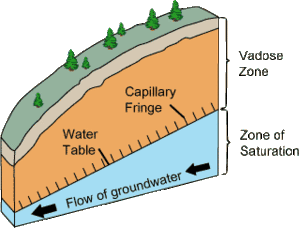Vadose zone




Vadose Zone
The vadose zone, also known as the unsaturated zone, is the part of Earth's crust located between the soil surface and the groundwater table. This zone plays a critical role in the hydrological cycle, affecting both water quality and quantity. It is characterized by the presence of both air and water within the pores of soil or rock. The vadose zone is a dynamic area where complex physical, chemical, and biological processes take place, including the filtration of pollutants, the recharge of aquifers, and the storage of water.
Characteristics[edit]
The vadose zone is defined by its unsaturated condition, meaning that the pores within the soil or rock are not completely filled with water. Instead, they contain a mixture of air and water, with the proportion of air being higher than in the saturated zone below the water table. The water present in the vadose zone moves downwards due to gravity and capillary action, a process known as percolation. The depth and characteristics of the vadose zone can vary significantly depending on the location, type of soil or rock, and the amount of precipitation.
Importance[edit]
The vadose zone is crucial for several reasons:
- Water Filtration: As water moves through the vadose zone, it is naturally filtered, which can reduce the concentration of pollutants and improve water quality before it reaches the groundwater.
- Water Storage: This zone can store a significant amount of water, which can be important for plant growth and can also contribute to the recharge of underlying aquifers during periods of drought.
- Biogeochemical Processes: The vadose zone is a site for various biogeochemical processes, including the decomposition of organic matter and the transformation of nutrients and pollutants, which can affect both groundwater and soil health.
Hydrological Processes[edit]
The movement of water through the vadose zone is governed by several processes:
- Infiltration: The process by which water on the ground surface enters the soil.
- Percolation: The downward movement of water through soil and rock due to gravity.
- Capillary Action: The movement of water within the spaces of porous materials due to the forces of adhesion, cohesion, and surface tension.
- Evapotranspiration: The combined process of evaporation from the soil and transpiration from plants, which can remove water from the vadose zone.
Challenges and Research[edit]
Studying the vadose zone presents unique challenges due to its variability and the complexity of processes that occur within it. Researchers use a variety of methods to study the vadose zone, including direct observation through soil pits or boreholes, remote sensing, and modeling. Understanding the vadose zone is essential for effective water resource management, predicting the impacts of climate change on water resources, and protecting groundwater quality.
See Also[edit]
Ad. Transform your life with W8MD's Budget GLP-1 injections from $75


W8MD offers a medical weight loss program to lose weight in Philadelphia. Our physician-supervised medical weight loss provides:
- Weight loss injections in NYC (generic and brand names):
- Zepbound / Mounjaro, Wegovy / Ozempic, Saxenda
- Most insurances accepted or discounted self-pay rates. We will obtain insurance prior authorizations if needed.
- Generic GLP1 weight loss injections from $75 for the starting dose.
- Also offer prescription weight loss medications including Phentermine, Qsymia, Diethylpropion, Contrave etc.
NYC weight loss doctor appointmentsNYC weight loss doctor appointments
Start your NYC weight loss journey today at our NYC medical weight loss and Philadelphia medical weight loss clinics.
- Call 718-946-5500 to lose weight in NYC or for medical weight loss in Philadelphia 215-676-2334.
- Tags:NYC medical weight loss, Philadelphia lose weight Zepbound NYC, Budget GLP1 weight loss injections, Wegovy Philadelphia, Wegovy NYC, Philadelphia medical weight loss, Brookly weight loss and Wegovy NYC
|
WikiMD's Wellness Encyclopedia |
| Let Food Be Thy Medicine Medicine Thy Food - Hippocrates |
Medical Disclaimer: WikiMD is not a substitute for professional medical advice. The information on WikiMD is provided as an information resource only, may be incorrect, outdated or misleading, and is not to be used or relied on for any diagnostic or treatment purposes. Please consult your health care provider before making any healthcare decisions or for guidance about a specific medical condition. WikiMD expressly disclaims responsibility, and shall have no liability, for any damages, loss, injury, or liability whatsoever suffered as a result of your reliance on the information contained in this site. By visiting this site you agree to the foregoing terms and conditions, which may from time to time be changed or supplemented by WikiMD. If you do not agree to the foregoing terms and conditions, you should not enter or use this site. See full disclaimer.
Credits:Most images are courtesy of Wikimedia commons, and templates, categories Wikipedia, licensed under CC BY SA or similar.
Translate this page: - East Asian
中文,
日本,
한국어,
South Asian
हिन्दी,
தமிழ்,
తెలుగు,
Urdu,
ಕನ್ನಡ,
Southeast Asian
Indonesian,
Vietnamese,
Thai,
မြန်မာဘာသာ,
বাংলা
European
español,
Deutsch,
français,
Greek,
português do Brasil,
polski,
română,
русский,
Nederlands,
norsk,
svenska,
suomi,
Italian
Middle Eastern & African
عربى,
Turkish,
Persian,
Hebrew,
Afrikaans,
isiZulu,
Kiswahili,
Other
Bulgarian,
Hungarian,
Czech,
Swedish,
മലയാളം,
मराठी,
ਪੰਜਾਬੀ,
ગુજરાતી,
Portuguese,
Ukrainian
